
For many homeowners living in rural areas or urban contact zones, snake encounters on the property are a concern. Most of these encounters are harmless, but venomous varieties, such as rattlesnakes, are not at all uncommon. Whether it be due to potential dangers or just because people just don’t like snakes, just how to keep them away is often a matter of debate.
In this article, we’ll cover methods of keeping snakes away that actually work, and which you should avoid. This is based on thousands of snake relocation and encounter records at homes in Arizona, and generally accepted advice and recommendations from qualified biologists and herpetologists across the country. What you will not find here are quips from pest control companies or your ‘interesting’ neighbor. Consider this your be-all guide for keeping snakes away, all based on real situations.
Fortunately, these are methods that can also not cause any harm to local wildlife, even the snakes that you probably dislike if you’re reading this article. Along with actions that will keep snakes away come others that will help you along the path of being ok with the ones that show up anyway.
Note: Because this information is based on our experiences with snake removal and prevention in Arizona, it will be most relevant for the prevention of rattlesnake species within the desert southwest. However, these basic principles can be applied anywhere with snakes in general, though perhaps not as specifically.
If you prefer to watch a recorded presentation that covers all of these topics for homeowners to keep rattlesnakes away:
1. No free lunch – eliminate rodents and other food sources.
Snakes are like other animals in that much of their activity is centered around looking for and obtaining food. For most species of snakes that show up in peoples’ yards, that food is a rodent.
Perhaps the best way to keep snakes away is to keep rodents away. Likewise, if your yard is full of unrestricted rodent holes, you’re more or less inviting snakes into the area. If you want to make an immediate dent in how many snakes may be showing up around your house, get on the pest control situation as soon as possible.
Rodent activity can attract snakes from far away, too. Rodents that may be coming in at night to eat the numerous food sources we as homeowners tend to provide leave scent trails that radiate well beyond the borders of your property. That means a snake crawling 100′ past your fence line could detect the rat that’s been getting into your dog food bin each night, and make a course correction to set up an ambush right outside your doggy door.
Unfortunately, this also means that having a generally higher number of rodents in the neighborhood can mean more snake encounters for everyone, so to a large degree, you may be left at the mercy of your neighbors. If there’s a property on the block that you suspect may be bringing more rodents into the area, do what you can to bring it to the attention to the homeowners.
Sometimes the neighbors bring the problem in.
For example, a home I recently visited to capture a Gophersnake had an immaculate yard free of any rodents. The neighbors’ property, however, where the snake crawled over the wall from, was different. Rows of citrus trees, and the leaves and fruits on the dirt, were attracting rodents from the nearby canal and elsewhere. The result is more snakes for everyone. The yard was otherwise very clean and well-maintained, but some situations create more rodent issues, and consequently snake issues.
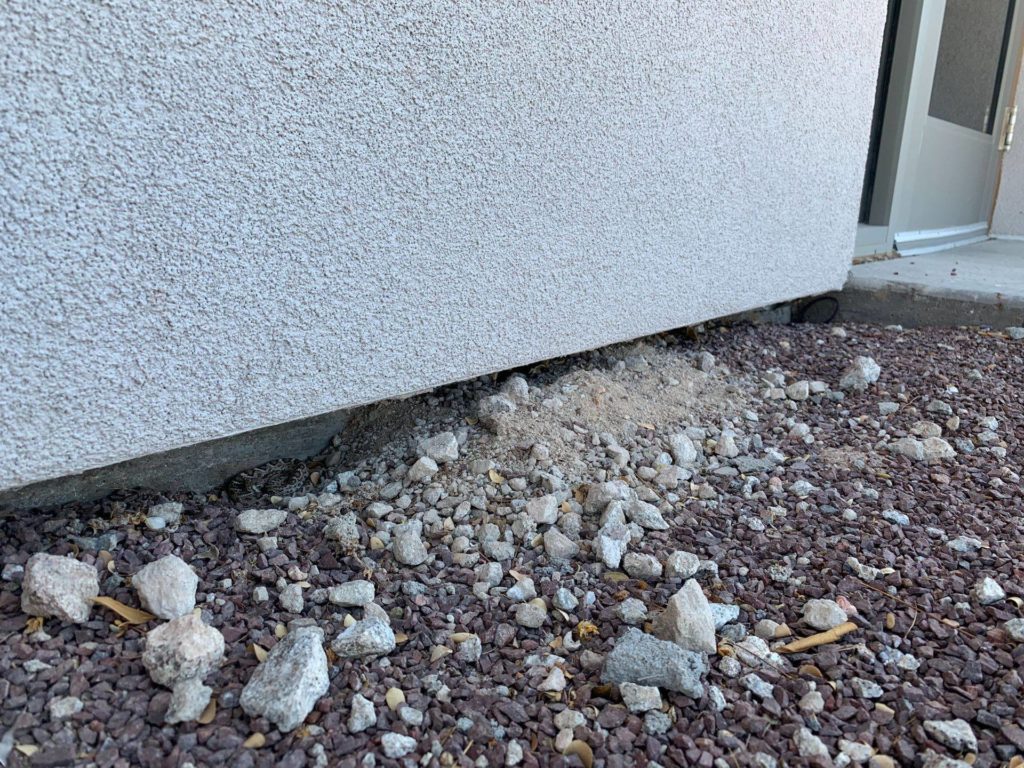
Not all snakes eat rodents – some are primarily interested in invertebrates and lizards. Though the causes are different, the same rules apply. The fewer prey items are available, the fewer snakes will be attracted to the area to hunt them.
An abundance of crickets, scorpions, centipedes, ants, and even cockroaches can support a variety of small snakes. These bug-eating snakes, like Groundsnakes and Nightsnakes, also tend to be the species that end up inside of the home, just by their nature. In general, the homes where we are called to retrieve multiple instances of these small snakes also have a high volume of insects. An abundance of bugs also helps support a larger lizard population, and then, of course, the snakes that prefer to eat lizards.
So while no snake is going to come into your yard to go after the dog food left outside, rodents will, and then come the snakes. Attracting rodents is the same as attracting snakes, and should be handled as such.
Many species of snakes (including rattlesnakes) also eat birds. If you live where rattlesnakes do, and have a bird feeder (or for squirrels, etc), expect to see rattlesnakes sitting in ambush at its base at some point. If you take action to invite wildlife to your yard, you should know it is inviting all wildlife to your yard.
Important note: in your effort to rid your yard of rodents, pass on any poison bait or traps that use rodenticide. If you use those products, you’re also killing bobcats, birds of prey, coyotes, and a variety of other natural predators. If your pest control guy says this doesn’t happen, spend a few minutes on Google to learn how wrong that is.
Steps you can do right now to reduce the number of snake-prey in your yard:
- Keep dogfood inside, and keep dog poop picked up as much as possible (yes, rodents eat it)
- Avoid using bird feeders, especially any that use seeds
- Find a good pest control company that can help (no poison bait!)
- Use water to flood and destroy rodent burrows when you see them
- Eliminate all food sources – fruit and nuts from trees, unsecured garbage, grease traps from the grill, etc.
2. Eliminate habitat – landscaping methods to prevent wildlife.
In the wild, vegetation is a very important part of the microhabitat systems that are used by snakes. The right plants provide cover, thermoregulatory dynamics, hunting opportunities, and more. Some of the same plants that we, as homeowners, often choose because they are pretty or provide a certain aesthetic, also give snakes ideal spots to hide and hunt.
The greatest offender? Lantana. These low-to-the-ground flowering plants seem to be on the list of default landscaping choices for most homes in Arizona. The problem? Snakes love them … rattlesnakes in particular. So do rodents, birds, lizards, and invertebrates that snakes eat. It’s not the plant itself that they like, but the deep leaf-litter almost always found under them. They tend to become quickly overgrown, are over-watered, and a mess in general. A decorative rock pile or wall lined with lantana is an absolute snake magnet.
Next on the list are any other plants that similarly provide deep cover opportunities, retain water, and catch a deep layer of rotting plant material. The silliest of these is the rosemary plant. There is a myth floating around out there that rosemary repels snakes, when in fact, the opposite is true.
Bush plants are best avoided if you don’t want to see wildlife.
The truth is, any plant that provides unchecked cover, tends to shed a lot of leaves, and needs to be often watered, is useful to snakes. If you have any plants that could be described this way, be sure to keep them as well-maintained as possible, removing all leaf litter, and carefully watering only as much as the plant needs. If you have these plants and wish to keep them, be sure that if you look at them from directly above, you can see some bare ground through the branches.
A rule of thumb for snake-unfriendly landscaping: if you have a bush that you’re not sure you love, get rid of it.
Some plants attract snakes by proxy. As described earlier, citrus trees (or any fruit-bearing plant) and trees that produce a lot of seeds or nuts can attract rodents and birds … which snakes will seek out.
If you prefer cactus, that’s great. They don’t use much water, don’t drop any leaves, and provide almost no shade. However, be careful with prickly pear (and similar) cactus. The base of these cactus is a common home for packrats, which are very important to rattlesnakes.
Perhaps the best thing you can do is to go natural – work with native plants and landscaping that doesn’t need a lot of water, and is easy to maintain. A variety of cactus, Palo Verde trees, ocotillo, creosote and others are all native to the Arizona desert and easy choices. Consider ditching the lawn and mid-western style yard for something a little more in-line with natural soundings, and you won’t be providing an unintentional oasis for snakes.
Steps you can do right now to reduce the number of snake-prey in your yard:
- Go natural – design landscaping with native plants, cactus and others that require less water and provide minimal shade
- Remove or replace lantana, rosemary, and similarly “heavy”, leafy and shaded plants.
- If you do keep lantana or rosemary, keep it well-maintained and always remove leaf-litter
- Change the watering schedule to be only as much as needed. If you have native plants that are healthy, consider removing the drip system entirely.
3. End the oasis – keeping water sources dry and unavailable.
Especially in desert areas, providing water sources can be a major source of snake encounters. Snakes need water, like all animals, and they’ll often stop by to take a drink when it’s offered.
Swimming pools are a common source of water, and you can’t do a lot to prevent that. However, a lot of swimming pool snake encounters are because the snake actually falls into the pool, and can’t escape. There are, fortunately, a lot of cheap products available to help with this. You’ll also inadvertently be finding fewer dead rodents in the pool, too.
Water gives much more than a cool drink on a hot day.
Water doesn’t just attract snakes that want a drink – free water sources are a place that other animals use as well. A dripping air conditioner condensation pipe, or example, makes a great bird bath, or spot for rabbits and rats to visit and get a drink. Snakes go where the prey is, and if you’re attracting a supply of rodents and birds, you’ll also attract the animals looking to eat them. Even worse, rodents that live and move well outside of your property lines may be using your home as a resource, and those scent paths lead right to back to your place.
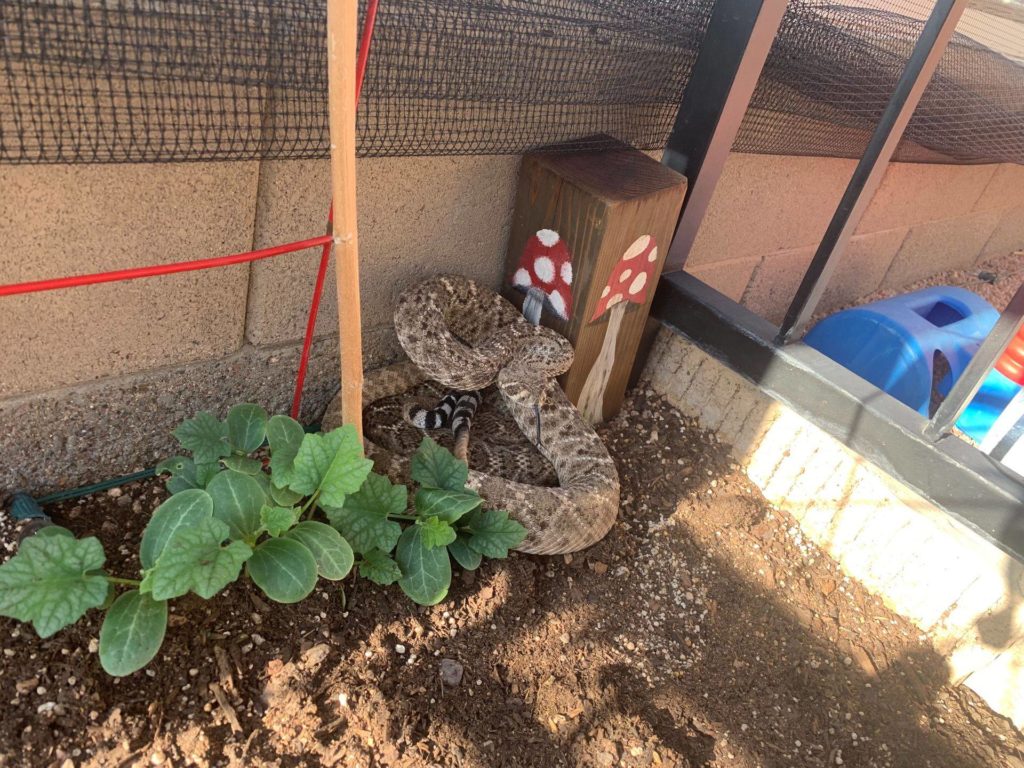
Water also helps to just keep an area cool, which is a major challenge to desert-dwelling animals, including snakes. A shaded corner of the backyard becomes even more attractive when the leaky hose provides, essentially, an evaporative air conditioner.
Automatic sprinkler systems and drip hoses are standard features with any new home in Arizona. They come with a lot of opportunities for wasted water and the creation of a mini-oasis for local wildlife, including snakes. If you have automatic sprinklers, be sure to adjust the timing to be just as much as is needed, in the places it should be. If there’s a native palo verde tree at the edge of your property, it likely does not need daily watering.
An unfortunately common part of new housing developments, from our experience, are poorly-planned and managed parks, often with “drip systems to nowhere” at the edges that are watering native plants, or in many cases, nothing at all. Even though this is not at all on your property, there may be something you can do about it (see the later section on homeowners associations).
Things you can do to reduce water sources and lessen the chances of finding a snake in your yard:
- Replace any leaking hose, spigot, or anything else that’s dripping. Wet dirt = snakes
- Buy and install critter ramps and filter covers to make sure snakes that do drink from the pool can escape
- Put a coffee can or bucket under air conditioning condensation pipes to avoid unintentional bird baths
- Adjust automatic sprinklers to be efficient and eliminate any waste
- Consider native plants and landscaping that uses less water
- Fountains, birdbaths, ponds, and decorative water features that can be removed, should be
4. Maximize exposure – even snakes want to stay cool.
While the common belief is that snakes like it hot, the truth is that they spend much of their time trying to stay cool. Active thermoregulation is the behavior of cold-blooded animals to seek out not just hot temperatures, but the right ones, and in the desert southwest that mostly means trying to stay out of the sun.
A body temperature of only around 110ºF is lethal to a rattlesnake. Anyone in Arizona who’s tried to go get the mail barefoot knows that the ground is much hotter than this almost any day. Through most of the year, the open, unshaded ground is simply lethal to snakes, and they will look for opportunities to stay cool.
That’s not much different than how we behave in an Arizona summer. Your property most likely has many of these shade opportunities as a result. But eliminating them to keep snakes away isn’t a simple task – it may require some tough choices, and could impact how the property looks and feels. Basically, the more that your yard resembles the surface of the moon, the fewer snakes will be able to make use of it. Most of us don’t need to go that far, and there are some easy solutions that can usually be implemented without a lot of aesthetic heartbreak.
Proper landscaping can help minimize shaded hiding spots.
As stated elsewhere in this article, landscaping choices have a large impact on how much cover is available to snakes. To keep snakes away, you’d be better off choosing plants that can be cut high off the ground and don’t provide overly shaded areas.
Hedges and rows of bushes along walls are notorious for providing shade to rattlesnakes. If you can’t see the ground under your bushes, it’s time to cut them back. If that’s not possible, it may be good to consider a different landscaping choice.
Decorative rock piles are a major source of snake conflict issues. Where we most often see these issues are in the decorative rock formations that are commonly placed near swimming pools. The concrete that is used to bind the rocks together deteriorates faster than the rock itself, leaving large openings that snakes love. If you have one of these features, make sure that it’s always well-maintained, and fix any issues that you see immediately.
Other types of decorative rock can also cause problems, but not for the reasons many people expect. The standard rip rap used to line properties and slow erosion is typically installed in a way that is far too shallow for snakes to make use of. If they’re looking for shade, they’d find an oven. However, if you have rip rap that is stacked or placed in a way that is multiple layers deep, you may have issues.
More than a meal: rodents are builders of snake homes.
As stated earlier, rodents should always be kept in check. In addition to being a food source, rodents dig tunnels and provide shelter opportunities for snakes. What’s better than a free meal? A free meal and a sheltered place to nap afterward. If you avoid providing these situations, snakes have little use for your backyard.
Rodent activity in some areas can create ideal situations to attract snakes. In particular, the concrete pads where pool pumps and air conditioning units are placed, are absolute snake magnets when combined with a busy rodent. These also tend to be in places where people seldom visit, and even heavy rodent activity can go unnoticed for a long time.
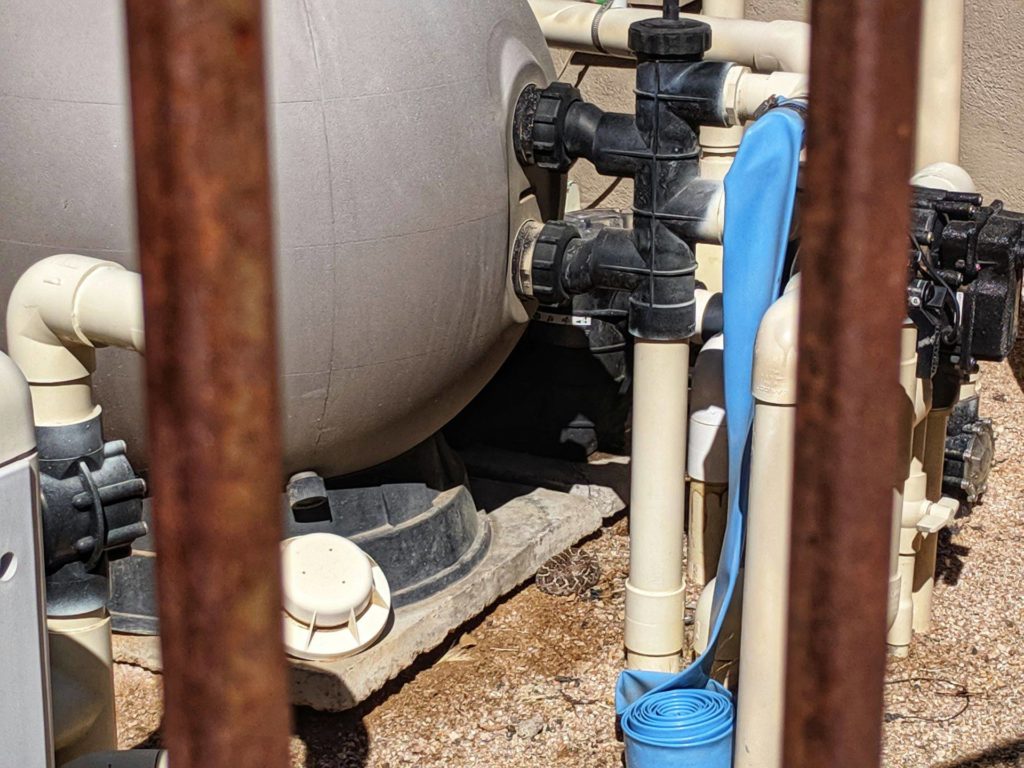
You may also be unknowingly providing shelter for snakes by just not having a clean yard. That’s always the elephant in the room when talking about how to keep snakes out of a yard, but quite simply: if the property is used to store junk, you can expect animals to move in.
We all have that area in the yard where we put our unused pavers, tiles, the woodpile, pool toys we mean to throw away, and other “some weekend when it cools down” items. These are most likely in the side-yard, or somewhere that isn’t under as much supervision as other parts of the yard, which all lead to ideal situations for snakes to move right in. One of the best things you can do right now to make your yard less attractive to snakes is to spend a Saturday going through the yard removing all of these items.
Any space where animals can get access to stay out of the heat should be considered a possible snake hiding spot. Other common situations are plastic tool sheds and pool toy boxes that are stored on dirt. If it’s cool, it’s useful.
Wood piles, too, are notorious for snake activity, especially during the winter months. If you keep a pile of firewood outdoors, make sure it is on a platform at least a foot above the ground. You should also rotate the wood pile out completely every season, and make sure that you don’t end up keeping a few perpetual logs at the bottom that just never get used. Consider moving the entire thing each year, too, to a new location. These actions will greatly diminish its usefulness to anything that may want to hide under it.
If you’re looking, here’s an example of an inexpensive solution to getting your firewood picked up off the ground: https://www.amazon.com/Landmann-82433-8-Foot-Firewood-Rack/dp/B0000TPRD6/ref=sr_1_4?keywords=firewood+rack&qid=1570465173&sr=8-4
Things you can do to reduce shade opportunities and see fewer snakes in your yard:
- Keep landscaping in a way that minimizes shade
- Decorative rock formations need to be well-maintained and rodent-free
- Rip rap and erosion-control rock placements should be only a single rock-layer deep
- Keep rodent activity under control, especially near structures like AC units and pool pump equipment
- Get rid of the junk and storage items in the yard
- Keep wood piles up off the ground, and rotate them out each season
5. Keep walkways clear
A surprising number of snake encounters happen right where people would least like them: right at the front door. This doesn’t necessarily mean that snakes really love these areas, though. It’s more likely that people just have more encounters here because it’s where we tend to be the most often. Every day we come and go from these entryways multiple times, so if something new is there, like a rattlesnake, we tend to notice it.
Covered entryways do provide some good stuff for snakes. Mostly, this is in the form of well-shaded cover. Covered entryways are a popular feature at most newly-built homes in Arizona, and these shaded overhangs superficially resemble the shallow caves and spaces that rattlesnakes call home during the summer months.
This is, of course, nothing you can do a lot about without some major changes to your home’s construction. But there are still some things you can do to help keep visiting snakes moving along, and less likely to set up shop opposite the welcome mat.
You want to keep the area as clear and open as possible. If there’s a snake there, you want to see it. The pots and decorations that are usually in the corners of entryways help provide a bit more cover, and we find snakes behind them every day. Pull them back, expose the space, and make it less of a hiding spot.
Avoid adding more water to further cool the area, too. If you have plants in the area, avoid situations that could further attract snakes. Lantana, rosemary, and other plants that provide deep cover only make these easy-to-access ‘caves’ all the more attractive to snakes.
To avoid snakes hanging out by the front door, here are some things you can do:
- Pull pots and plants away from the corners and leave as much space as possible between it and the wall.
- Avoid extra plants or landscaping that provides deep cover
- Keep decorations to a minimum, or none at all
6. No free rent – keep up on building maintenance
Perhaps the greatest potential source of shelter for snakes on any property is the house itself. It doesn’t take much for a rodent to get into a faulty foundation, dig under patio pavers, or otherwise create access for snakes to move in.
The best way to keep that from happening is to simply keep absolutely up-to-date on any maintenance issues that pop up. If you see a crack in the foundation, don’t wait, get that fixed immediately. The more time it goes without correction, the more rodents will dig into it, animals will learn to use it, and the more your foundation turns into a welcoming, cool cave.
As stated earlier, decorative rock formations are great to attract snakes to a property. It’s not the rocks, but the tendency for them to quickly degrade. If you see any cracks forming, fix it right away. That goes for any other similar situation (mostly associated with the pool). If you see a crack, fix it.
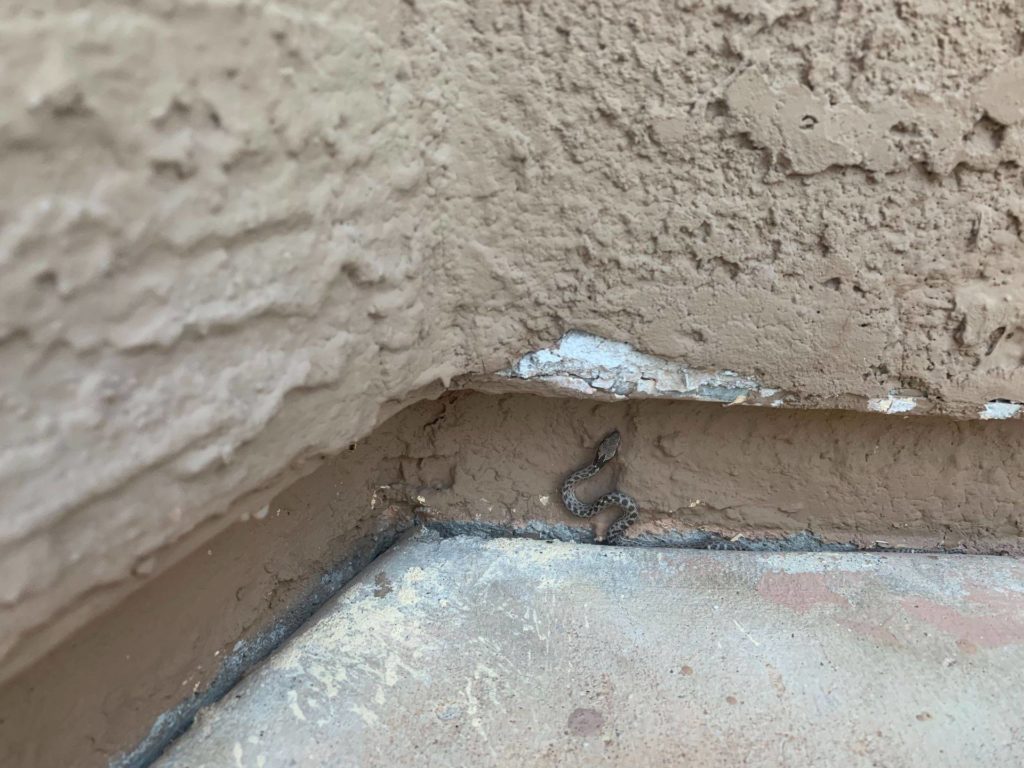
Concrete areas, like driveways and walkways, are often installed over material that makes it easy for rodents to dig. This can create caves that snakes may find useful. Along with any other area of the property, make sure to jump right on any cave that looks to be forming underneath. We have recovered many rattlesnakes over the years from holes caused by rodents or erosion in these situations.
Manufactured homes present another issue, often requiring more immediate attention than homes with a dug-in concrete foundation. The skirting material that surrounds the base of the home is often poorly sealed and comes apart easily after only a few years. Every year, we receive numerous phone calls from homeowners who discover (usually by someone trying to fix the air conditioning ducts under the home) that there are rattlesnakes living underneath. If you have a manufactured home, I can’t stress enough that your skirting needs to be sealed completely and always in top condition.
Things you can do to your buildings to see fewer snakes in your yard:
- Fix any maintenance issue immediately, especially if it could provide access to the foundation
- Watch for rodent activity and erosion under concrete areas, walkways, and the driveway
- Always keep the skirting around manufactured homes in flawless condition and allow no access under the home.
- Any deterioration or gaps in the flashing along the underside of the home should be fixed immediately.
7. Keep out and stay out! – physical barriers and snake fencing
The best thing that you can possibly do to keep potentially dangerous snakes out of your yard is to install physical barriers. These barriers may work better for some species than others, but the majority of the solutions out there focus on keeping venomous snakes out.
Avoid anything called a “snake trap” or any sort of fencing, plastic mesh, or netting that actually captures and kills the snakes. Even if you don’t care much about the well-being of the snakes, you’ll also be killing a lot of other animals that people do tend to like, like birds, rabbits, lizards, and others. You could also be put in danger by having to deal with a trapped, injured, and terrified rattlesnake.
Nonvenomous and small snakes can climb walls and other surfaces that provide sufficient grip. Something like a Gophersnake, Ratsnake, or Kingsnake is going to be able to get where it wants to in most cases. Fortunately, this isn’t an issue … they’re harmless.
There should be some separation between the goals of preventing snakes when it gets down to it. Snakes that are harmless that people would just rather not see, and snakes that do actually pose some danger. A solution that is effective for the dangerous snakes, but does not make claims to keep out harmless ones, is a realistic and worthwhile answer to your problems. If anyone does claim to be able to build something that will keep all snakes out 100%, they’re lying to you.
Rattlesnake Fence Installation is a service that places materials, such as steel and concrete, in and around features of the property to create a space that rattlesnakes cannot physically enter. This is something that is often performed by landscapers, pest control companies, and a variety of handyman types … but in evaluating hundreds of yards where this service has been performed, one thing stands out: rattlesnake fencing is not a do-it-yourself task. There are some very specific factors at play that require deep understanding of rattlesnake behavior and physical capabilities. When you’re looking for a rattlesnake fence installer, go with a specialist or don’t bother.
Any materials that are used for rattlesnake fencing need to be permanent. Avoid any plastic, zip-ties, rubber, or anything that will wear out in the sun. Based on basic rattlesnake biology, and a lot of testing we’ve conducted ourselves in our facility, here are minimum requirements for a successful “snake proofing”:
- Steel, no rubber or plastic
- Installed to a minimum of 30″ (ideally 36″) above the nearest flat surface.
- The largest opening in the entire perimeter of the yard must be a maximum of 1/4″, including gates
- If installed against the ground, it must be trenched (buried) into the ground a minimum of 4 inches, preferably more and angled properly.
- Use screws and metal materials
- ALL entry points must be sealed, or there’s no point to it
- Concrete and steel used on all gates, with no way to dig under them.
If you are going to install rattlesnake fencing, be sure that the perimeter is completely sealed. One of the most common scenarios we are called to collect snakes from is a yard where snake fencing has been installed on the fence, but the gates have not been modified. This is where what was intended to keep rattlesnakes out ends up being a snake trap instead. A reputable snake fence installer will walk away from projects where a homeowner insists on only a partial job, so if you plan on installing physical barriers, that’s a question you could ask them to see how much they really know about it.
Rather than go into detail about how to select a snake fence installer, I’ll include a link to this detailed article about how to shop for a rattlesnake fence installer like an expert.
Things you should consider when looking for a snake fence installer
- Does the company have rattlesnake experts on staff or any specialized snake-specific training?
- Do they specialize in rattlesnake fencing and snake prevention, or is it something they do “on the side”?
- Do they have installation standards based on science and what snakes actually do?
- Do they have a good method to seal gates and entryways entirely without any gaps?
- Do they use permanent materials, like steel and concrete?
- Do they put emphasis on aesthetics and how the finished product looks?
- Do they have good customer service?
- Do they have numerous good ratings (Google, Yelp, etc)?
- Do they make you pay a large deposit (avoid this)?
- Are they able to answer your detailed questions about snakes, how to keep them away, and how snake fencing fits into the big picture?
- Are they licensed, bonded, and insured?
8. Snake repellents – a stinky scam
There are a number of products on the market that make the claim that they can keep snakes away. While some are chemicals, and others are mechanical or create vibrations, there’s one thing they all have in common: snake repellant products do nothing at all to deter snakes from your yard.
How do I know? As the owner of one of the busiest snake prevention and removal business in the world, I have personally captured hundreds of snakes from yards heavily treated in these products. If expanded to our entire team, that figure is in the thousands. Our records indicate that there is no correlation between spending money on this stuff and seeing fewer snakes in your yard.
Pest control companies will disagree, but that makes sense. Many just don’t know that they don’t work and honestly believe they are helping their customers. However, I’ve had far too many personal conversations with pest control operators where something like “we know it doesn’t work, but our customers ask for it” is muttered. If you’re wasting money on this stuff: cancel it immediately, and or spend that money on increasing (non-poison) rodent control.
There are other regional myths that are passed around as well. The idea that mothballs, rope of any kind, coffee grounds, rubber pellets, the skin of a kingsnake, cat urine, or any others out there actually keep snakes away is not based in reality.
Some may disbelieve all of this, but that’s easy to explain. This is an example of confirmation bias, where information is unintentionally selected that supports a belief. If a person spends hundreds of dollars on a snake repellent, then reports that they see fewer snakes, that person may be left with the idea that snake repellents do indeed keep snakes away. However, it’s more likely that they just haven’t seen more of them, and they are doing other things right as a result of an encounter. By the numbers: don’t buy this junk.
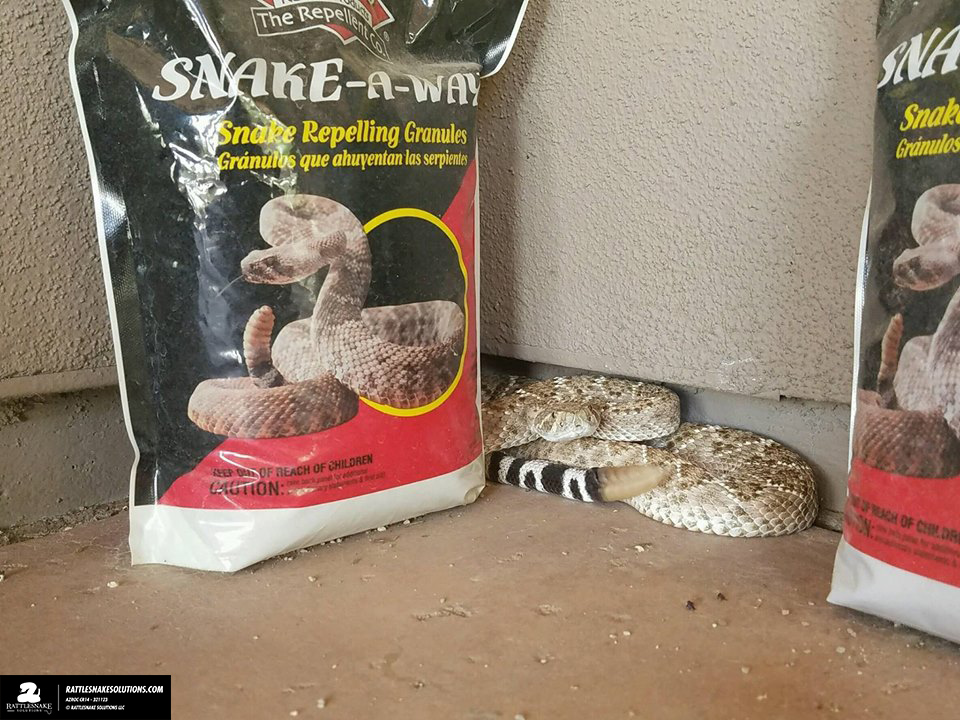
9. Make the Home Owners Association do their part
Some of the biggest issues that we see in neighborhoods where snakes are common aren’t even things that the homeowners can directly control. These are areas between properties, along the edge, the parks, drainages, and areas that are managed by the property managers and homeowners association.
But, just like overgrown grass or some other problem with the neighborhood, you can (or should be able to) demand action if you believe your safety is in danger.
A major offender here are the drainage catchments and parks at the end of outer-area blocks. The default design tends to be just to water everything, even native plants that don’t need it. They create a well-watered, cool transition against the dry desert, and rattlesnakes love to hunt here. If you have one of these parks around your home, especially if you live at the end of the block, you can expect to see more snakes.
In areas like much of Cave Creek and Scottsdale, Arizona, there are spaces between properties where native vegetation is maintained. In these areas, fed by an abundance of trash and citrus-fueled rodents, snakes can have a pretty great life. When it gets too overgrown, however, you may start seeing them in your yard. Even if you have something as effective as a rattlesnake fence installed, if the neighboring trees are growing over it to create a bridge, you’ll have issues. Ideally, all vegetation and trees should be cut back a minimum of 3 feet from the edge of your wall. The clear area will help reduce the usefulness of the wall to rodents, and therefore, snakes. This should be something you can request from the HOA, or have it taken care of yourself with approval.
Some HOAs have rules that actually prevent you from doing what you need to protect your property from potentially dangerous snakes. A great example of this are the varied and largely arbitrary rules dictating the installation of rattlesnake fencing. These seem to be based on appearance alone, ignoring the fact that something as important as a rattlesnake fence needs to, primarily, provide the function of keeping venomous snakes out of a backyard.
The height requirements, approved materials, and installation techniques should be designed for this purpose, but sadly, usually are not. In our experience, most HOAs will gladly modify their regulations if they learn that they are preventing the safety of their residents. Of course this can take a bit of work, so gather information and be prepared to make a case. If you contact the HOA concerned for your safety, and then you are denied the ability to handle that, this may present some concern for them. You can find the most complete list of tested, effective snake fence installation standards in this article.
Things you can request from your HOA to see fewer snakes in your yard:
- Modification to drainages and parks to cut back on excessive or redundant watering, especially at the edges.
- Cut any outer-area vegetation back at least 3′ from the wall or fence. This can be requested from the HOA directly, or as permission to do it yourself.
- Make sure you are able to install snake fencing to the correct specification to actually do the job. If HOA regulations prevent that, campaign to have those rules changed.
10. Your garage is not a cave – your house isn’t either!
Each year, especially in the early spring and again in the hottest times of the year, we are called to capture hundreds of snakes found in garages. The reasons are simple enough – the garage, when accessible, is just a cave. It’s useful to stay warm in the winter, and provides refuge from the brutal summer heat. When the ‘cave’ is filled with a bunch of junk that’s been sitting there for years and even has some mice here and there, why shouldn’t snakes move right in?
You can prevent this, largely, by simply preventing access to the garage. Make sure the garage-door seal is in great condition and fully seals against the ground when closed. Remember that some snakes are tiny … rattlesnakes only need just more than a quarter inch to get in, so make sure it’s absolute. Make sure it is sealed all the way to the sides, and there are no gaps in the moulding or deterioration in the concrete. Any seams or gaps should be filled in along the base where the door closes, too, to prevent snakes from just crawling right in. If you see leaves and dirt in the garage-corners by the door, that’s a good indication that there’s more than enough space for snakes to get in, too.
During the shoulder seasons, when snakes are moving to and from winter den sites or are otherwise very active, make sure to keep the garage door closed. Leaving the door open for long stretches of time on the weekends, which we all can be guilty of from time to time, snakes can crawl right in. Even worse, you can trap them in there when you close the door. If you live in an area where there are a lot of rattlesnakes, consider an open garage an invitation.
For storing items in the garage (who doesn’t?), make sure that they aren’t positioned in a way that would make them useful to snakes. If you can, use plastic boxes or other storage bins that prevent entry, and keep them up off the ground. If you have long-term storage items, make sure that you change their location from time to time, or store them on elevated shelves.
An item that is notorious for snakes is the fake Christmas tree. They are used once a year for a month, then stored again until the following year. They’re completely ignored in the meantime, and we’ve removed more snakes from these fake trees than any other single feature within buildings.
Things you can do to keep snakes out of your garage:
- Make sure that the door seal and edges are in perfect shape and seal the outer area completely
- Keep the garage door closed at all times unless you are actually coming and going
- Keep any stored items away from walls at last a few inches, use plastic bins, and elevate them on shelves whenever possible.
- Don’t use the garage for long-term storage. The more stuff is in there, the more snakes (and other things you’d likely not want in there) can use it.
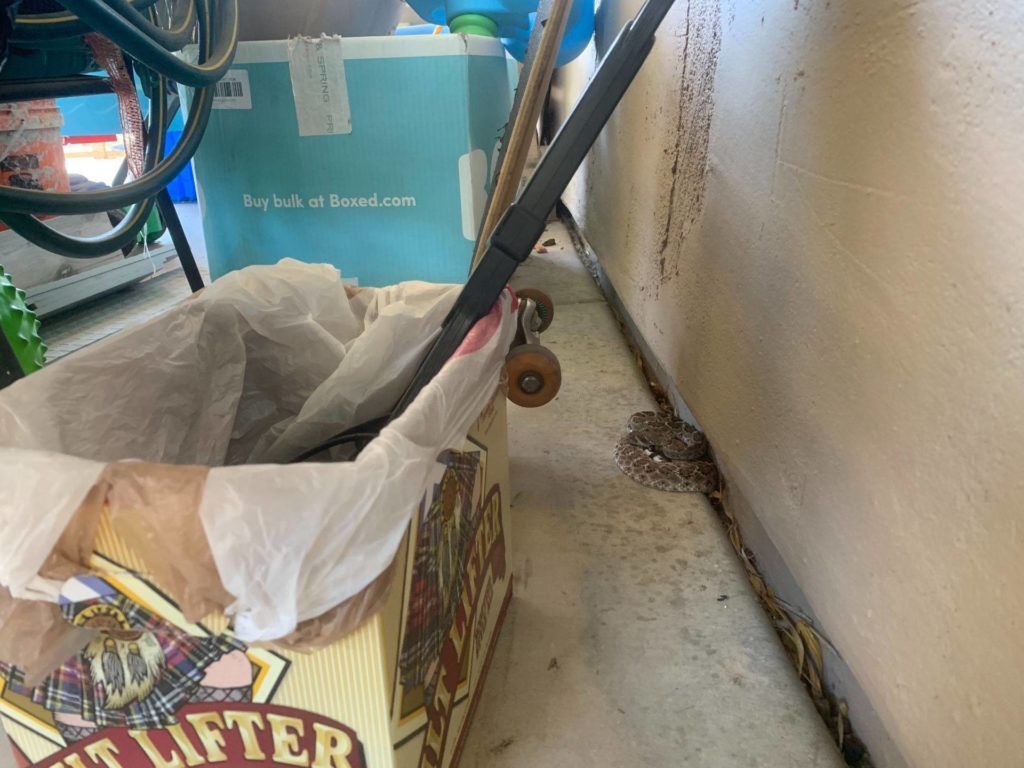
Something you won’t really need to worry about as much as most people think they do: rattlesnakes (or other venomous snakes) coming inside your home. We do very occasionally get a call to capture a rattlesnake inside a home, however it’s exceptionally rare, and generally easy to avoid.
In most of these cases where a rattlesnake is inside a home, the answer to how it got there and why it’s there is obvious. The door was left open on a spring day, the garage was left open while the homeowners were on vacation, etc.. In one instance, the home was so full of rodents that the place should have been condemned, and a rattlesnake moved right in to take advantage of it. These are not typical situations, and rattlesnakes being found inside homes is also atypical.
Other types of snakes may be able to get in other ways. Fortunately, these are very seldom dangerous, but it’s understandable that you’d not want them inside the house! Most of these come in through pretty small openings, like unsealed gaps in doors, and the tracks in sliding glass doors.
In Arizona, a snake that is notorious for getting inside the home is called a Nightsnake. They are often found in the bathroom, kitchen, or laundry room. The reason: pipes. They often end up coming up through drains and into the home.
In some homes, too, the way that cabinets are installed leaves an easy way in for snakes. If you look under the sink, you’ll likely see that pipes are nice and sealed into the hole coming into the cabinet. Behind the cabinet, however, there may be a large hole around the pipes coming into the home. If the cabinets aren’t sealed well underneath, that means there’s direct access from underneath the home to your master bath.
Things you can do to keep snakes out of your home:
- Keep doors closed at all times (even nice spring days). It doesn’t take long for a snake to cruise right in.
- Make sure sliding doors are sealed up tight
- Seal all holes around pipes leading into the house, and make sure cabinets are sealed all around (even under the overhang)
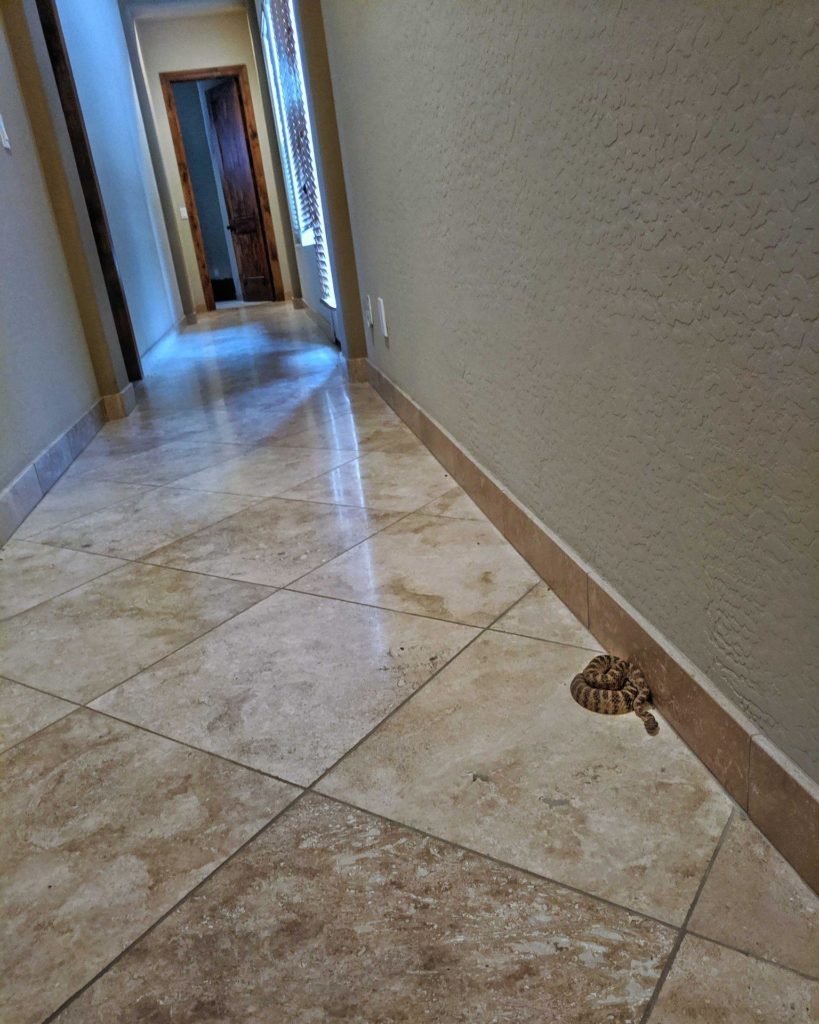
11. Sometimes, there’s nothing you can do.
Sometimes, even if you do every single thing on this list, and make your yard look like the surface of Mars … snakes will still show up. The reason: you happen to live where there are a lot of snakes! Without physical barriers, and no matter what you do to make the yard less attractive to snakes, there is always the possibility for random snakes to be passing through and have an encounter with you.
Some houses are more susceptible to this than others. A great example: houses at the end of the street tend to get many more snake visits than houses on the interior. The shared block wall behind rows of homes, with desert or a wash behind it all, acts like a funnel. Rodents (and snakes) follow the walls one way or another, and if you’re on the end of that funnel, your backyard is the first opportunity to hide, get a drink, and more. This is something for the snake-phobic keep in mind when shopping for a home near wild areas.
Things you should consider with purchasing a home, if you don’t like to see snakes:
- Buy on the interior of the neighborhood, rather than the edge.
- The last house on the street will usually see more snakes than the others
- Contact a snake removal service to ask about specific neighborhoods to gauge how snake-friendly it may be
- Ask your realtor about snake activity in the area
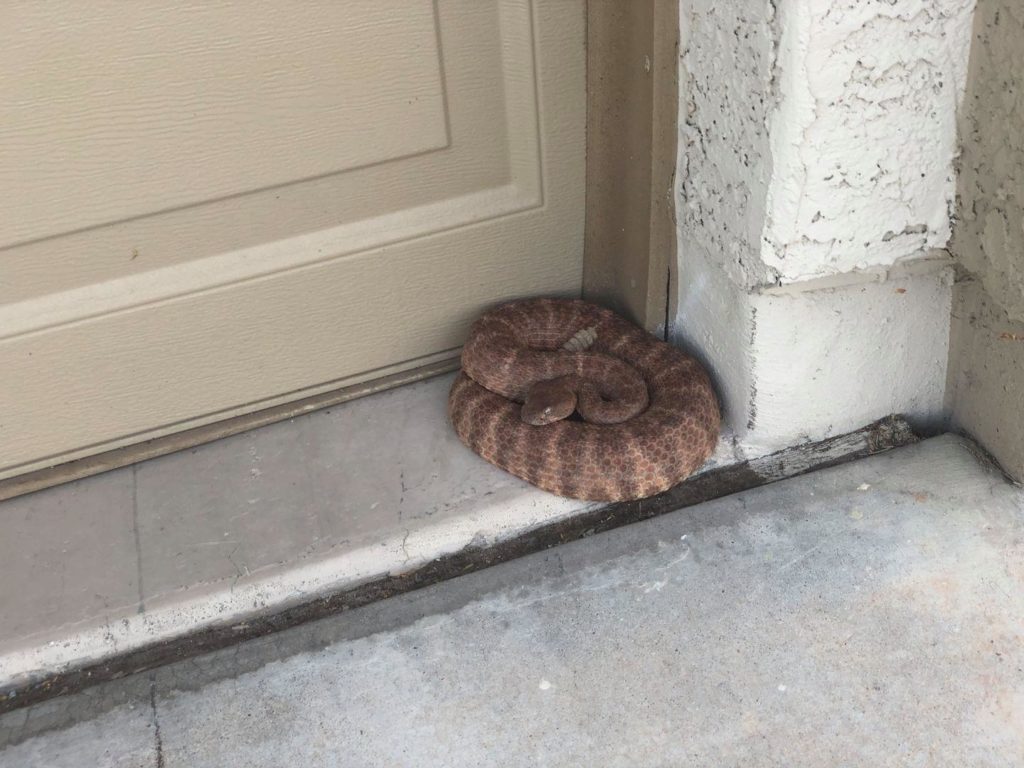
12. Learn everything you can about the local snakes
One of the best things you can do to keep yourself and your family safe from snakes is the very activity you’re doing right now: learning about them. Each environment and area has its own variety of snakes, both venomous and harmless, and the more that you know about them, the better you’ll be able to make decisions. Those decisions are both important during the prevention state of snake-safety, and perhaps even more so when you do happen to come across a snake in your yard.
So the snake you just saw racing through your backyard bushes … it was grown, kind of blotchy, thin, but not too thin … is it dangerous? Do you have to lock up the dogs and kids? Move to Canada? Burn the house down? If you had even a basic understanding of the snakes that live in your area, you’d know that, even if it’s not something you care to see, it’s nothing to worry about.
Just about every city or county has some sort of local educational resource available to help you learn the natural history of your local variety of snakes. You can find dedicated reptile-related nature groups, and Facebook groups that offer information and assistance with the identification of snakes. Your local nature center at your regional and municipal parks will also have good information.
Here in Arizona, as an example, Rattlesnake Solutions provides daily educational photos, videos, and stories on social media platforms, including Facebook and YouTube. You may also find a listing of free educational presentations on the rattlesnakes of Arizona, and safety education sessions for to homeowners associations and regional parks.
Here are some examples of the types of educational materials that are out there in abundance. Even if you’re not really interested in snakes at all, or even science in general, knowing the details of the things you fear can greatly help diminish that fear at the time you may most need it. Eliminating fear is all about preparation, and with snake-related fears, that opportunity exists in abundance.
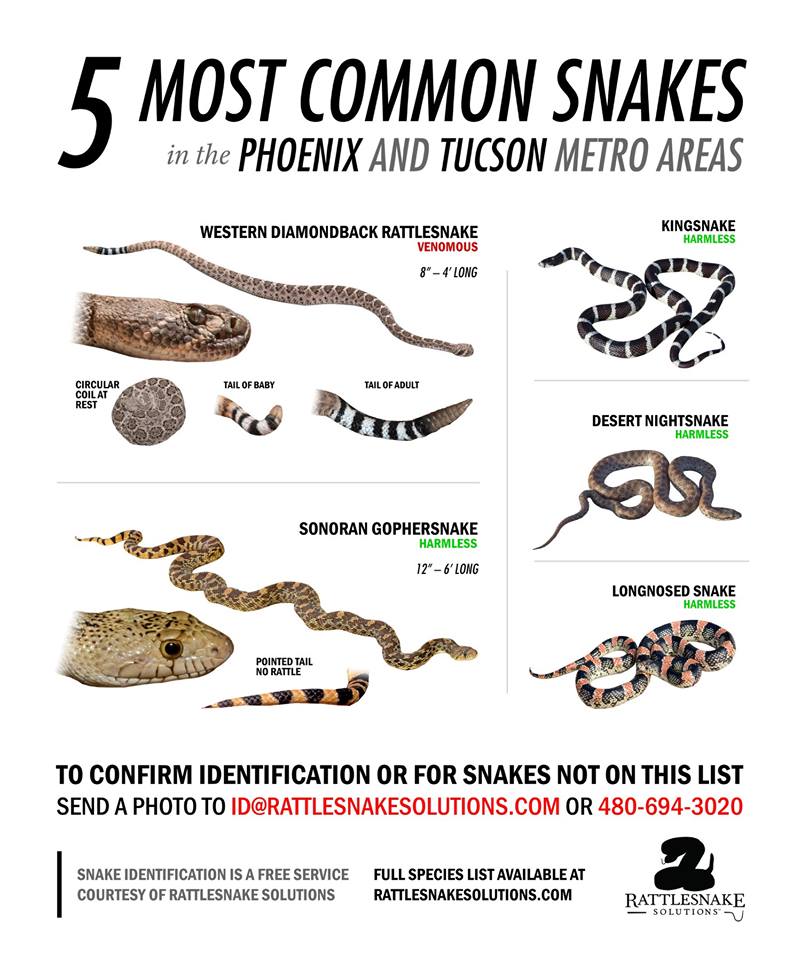
13. If you do see a snake:
Despite all efforts, if you live where snakes do, you will likely run into one at some point. From the experiences of thousands of our customers: it will be when you aren’t expecting it, and you will be ok.
As stated previously, if you’ve done your homework, you may already know which species it is (or at least, if it’s dangerous or not). Depending on level of knowledge, how fearful you are of snakes, and other factors, there are a few things that you can do to help make the situation safe and feel better about the whole thing.
First, you’ll want to identify it. If you don’t know, take a quick picture and send it to a local snake expert. That could be a herpetologist at your local university, or a nature guide at the nearest regional park. There should be quite a few services out there (including groups on Facebook) that offer free snake ID services. This is something best done long before you ever see a snake, so you can access it quickly without having to search for it.
If it’s a harmless snake, you really don’t need to do anything at all. While there may be some reasons why people still want to remove harmless species of snakes, this would be purely for the benefit of the snake and to ease fears. Whenever possible, once it is known that a snake is harmless, it’s best to be just left alone and it will leave on its own.
If it is a venomous snake, or you are unsure, do not under any circumstances attempt to capture, kill, or otherwise harass the snake yourself. This is not only, ultimately, not the most useful action, but it puts you in danger. Call a snake removal service, or wait for the snake to leave. If you call a snake removal group, follow their instructions, and they should be able to remove the snake, as well as provide a few other key services.
While the intention is respectable, it may not be best to have the local fire department or well-intentioned neighbor handle the situation. They’re not usually well trained in what to do with the snake after it’s been captured, and often injure the snakes in the process. Instead of a rattlesnake in the yard, you could end up with an injured, panicked rattlesnake dropped on the other side of your yard, trying to return. It’s best to stick with professionals.
While the snake removal person is at your home, and after the snake has been captured, ask them a lot of questions … after all, you are most likely paying for it! Ask them to search for more snakes, and why the snake they just caught was there to begin with.
Ironically, actually finding a snake in the yard is often the kick-off point for learning about how to avoid them. If you are reading this article, and have read this far, there’s a good chance it all started with a snake sighting.
If you see a snake in your yard:
- Try and take a quick photo of the snake, and send it to the snake identification experts that you’ve already taken note of
- If it’s harmless, leave it alone. It will leave.
- If it’s venomous or you aren’t sure, either leave it alone, or call a professional snake removal service to handle it.
- Do not attempt to handle it yourself, or allow a helpful neighbor do the same. You would be putting yourself in danger and may be responsible if someone else does the same.
- Watch the snake until help arrives
- Ask the snake removal person about why the snake is there, how it got into the yard, and how to prevent more from showing up
Above all, don’t worry too much 🙂 Snakes aren’t out to get you.
In most places where snakes can be found near homes, this is a hot topic. Snakes are a topic people seem to even, to some extent, enjoy fearing and not knowing much about. However, inevitably, the more that even the most snake-fearing person learns about them, the smaller and smaller the threat becomes.
Remember that in the United States, snakebite is almost never fatal. Accidental bites (where the person isn’t playing with it or trying to kill it) are very rare, too. The danger is mostly in our collective minds, and part of American culture. Odds are, you really don’t have as much to worry about as you may think. You may never want to see a snake in your yard; just remember that snakes don’t want to meet you, either!
